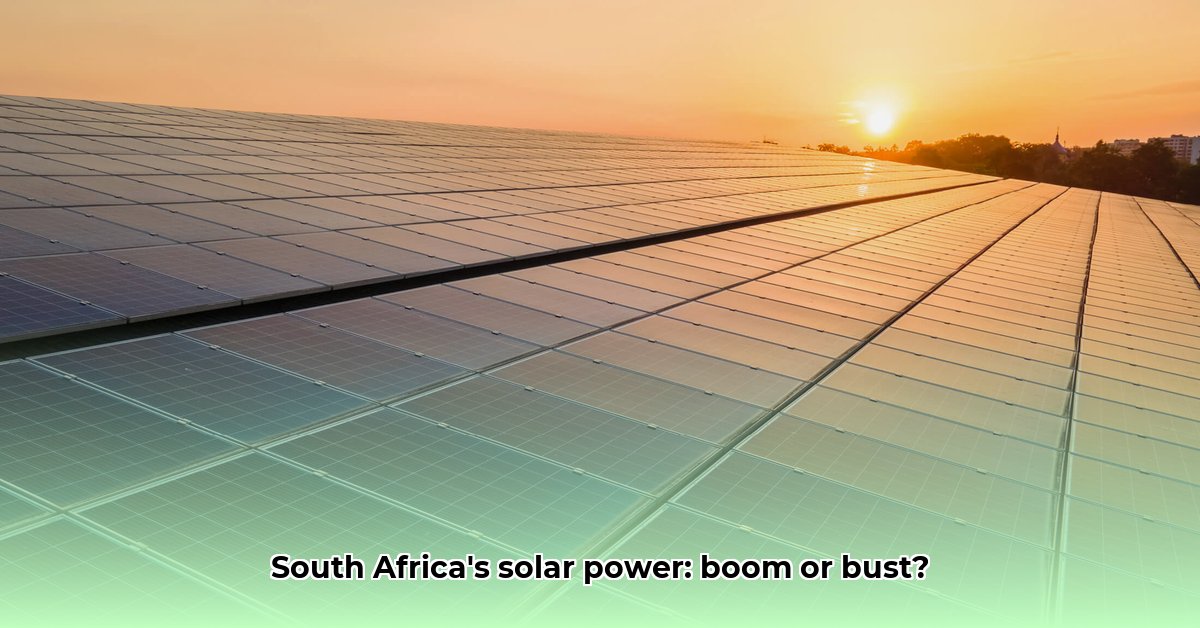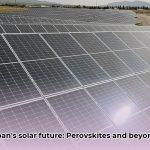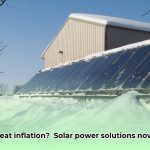South Africa’s electricity sector is undergoing a significant transformation, driven by a surge in solar energy adoption. This evolution presents a compelling story of remarkable expansion, with an increasing number of homes and businesses embracing solar solutions. Simultaneously, it highlights significant challenges, influenced by factors such as rising electricity costs, strain on the national power grid, and evolving government policies. For more on South Africa’s solar energy transition, see this helpful resource: South Africa Solar. This article explores the dual nature of South Africa’s solar energy transition, spotlighting both the impressive advancements and the complexities involved in integrating this clean energy source into the grid. We’ll explore the influence of governmental regulations, the necessity of enhancing grid connectivity for new solar systems, and practical steps for homeowners considering solar power adoption.
The Solar Power Surge: A Sustainable Energy Transition in Progress
South Africa’s pursuit of energy independence is gaining momentum, fueled by the dramatic increase in solar power implementation. This transformation goes beyond mere solar panel installations; it embodies a story of progress, challenges, and the potential to reshape the nation’s energy future.
Solar Panel Installation and the Renewable Energy Boom
Statistical data highlights this surge. Years ago, utility-scale solar installations were minimal. As of July 2024, South Africa had 2,287 MW of installed utility-scale PV solar power capacity in its grid, in addition to 5,791 MW of rooftop solar and 500 MW of CSP. Projections forecast continued growth, with estimates reaching 8,400 MW by 2030. The proliferation of residential and commercial rooftop solar power systems witnessed a remarkable surge.
Several factors are driving this growth. The cost of solar panel manufacturing has decreased substantially, improving cost-effectiveness. An influx of imported batteries signals a heightened understanding of energy storage. Government policies have been instrumental, including tax incentives for businesses, municipal inducements, and rebates for residential solar installations. Initiatives such as the Renewable Energy Independent Power Producer Procurement Programme (REIPPP) have fostered utility-scale solar entities like Xina Solar One, Karoshoek Solar One, and Khatu Solar Park. These projects contribute to sustainable energy generation, job creation, economic growth, and environmental awareness.
Grid Modernization and Addressing Solar Energy Challenges
This rapid proliferation has encountered obstacles. Eskom, South Africa’s power utility, is experiencing financial difficulties. Concerns exist regarding potential job displacements in the coal sector, a transition demanding careful planning to avert social and economic disruption. Some Independent Power Producers (IPPs) are bypassing Eskom, connecting directly with industrial customers.
Regulatory bottlenecks pose another challenge. While the government is streamlining the approval process for connecting small-scale generation systems to the grid, inconsistencies persist. The absence of a comprehensive registration protocol for small-scale embedded generation (SSEG) complicates monitoring total solar energy production. Can South Africa accelerate these regulatory modifications to leverage its solar potential and promote renewable energy use?
Solar Energy Infrastructure and Grid Integration
The expansion of distributed generation (e.g., rooftop solar systems) introduces challenges to maintaining grid stability. The capital expenditure associated with energy storage currently limits the potential of solar photovoltaic (PV) systems. However, Concentrated Solar Power (CSP) technologies offer viable integrated storage. The rising import of batteries suggests increasing awareness of residential and commercial energy storage to augment reliability and mitigate load shedding.
Solar Energy Investment and A Brighter Future
Achieving a solar-driven energy landscape requires collaborative efforts. The following table outlines measures for energy sector participants:
| Stakeholder | Short-Term Actions (0-1 year) | Long-Term Actions (3-5 years) |
|---|---|---|
| Eskom | Negotiate power purchase agreements with solar producers; modernize grid infrastructure; invest in large-scale battery storage solutions. | Transition to a diversified energy mix; actively participate in the REIPPP program; undertake operational restructuring to adapt to the changing energy landscape. |
| Government | Streamline the REIPPP; update energy regulations; improve SSEG registration processes; address Eskom’s financial issues; maintain existing incentive programs. | Invest in grid upgrades; boost research and development in energy storage technologies; create a comprehensive national energy policy; implement the Just Energy Transition Partnership. |
| Private Sector (IPPs) | Prioritize projects with strong grid connections; integrate battery storage into new projects; forge partnerships with Eskom and other stakeholders. | Invest in technologies; explore new market opportunities; participate in public-private partnerships. |
| Residential Consumers | Utilize rebates; install rooftop solar PV systems with storage; consider community solar projects. | Participate in net metering programs; advocate for better grid infrastructure; implement energy efficiency measures. |
The trajectory of solar energy in South Africa is promising. However, achieving its potential requires addressing challenges, reinforcing collaboration, fostering innovation, and cultivating a long-term vision for South Africa’s energy future.
Selecting the Ideal Home Solar Battery System in South Africa
South Africa’s solar energy story involves both advances and challenges. While the country benefits from sunshine, integrating solar energy into the grid poses difficulties. This underscores the importance of selecting a home solar battery system effectively meeting one’s needs.
Renewable Energy Integration and Navigating the South African Solar Landscape
The capacity for solar energy utilization in South Africa is substantial. However, factors such as load shedding, unreliable grid infrastructure, and unpredictable energy prices are driving homeowners toward independent power solutions. This context makes selecting the best home solar battery system exceptionally relevant.
Solar Panel Efficiency and Key Factors to Consider
Prior to considering brands or models, homeowners must thoroughly evaluate the following:
- Energy Needs: Assess your household’s energy demands to determine the necessary size of the battery system.
- Budget: Create a realistic budget, considering available financing options.
- Space Constraints: Evaluate available space for rooftop or ground-level installation, impacting system size and placement.
- Technical Compatibility: Ensure compatibility between the chosen system, solar panels, and existing electrical systems. Professional installation is advised.
- Warranty and Maintenance: Assess warranty coverage and long-term costs associated with maintenance.
Solar Battery Technology and Choosing the Right System
Once energy requirements are understood, the selection process becomes straightforward. Research brands and models, evaluating specifications and price points. Solicit quotes and assess third-party reviews. Remember that selecting the best home solar battery system necessitates carefully weighing these considerations.
Smart Grid Development Potential Challenges
Despite advantages, solar battery deployment has challenges. Regulations, grid limitations, and installation intricacies can prove difficult. However, the long-term advantages often outweigh initial costs.
Keys to Solar Energy Success:
- Understanding your energy needs.
- Budgetary considerations.
- Available space.
- System compatibility.
- Warranties and maintenance costs.
Proven Tactics for Residential Solar Energy Adoption in South Africa
Key Takeaways:
- South Africa’s sunshine and energy crisis incentivize residential solar adoption.
- High upfront costs, lack of awareness, and security concerns remain barriers.
- Successful strategies involve financial incentives, public education, and technical support.
- Government initiatives need expansion to reach low-income households.
- Collaboration between government, Eskom, and the private sector is crucial.
Solar Investment and The South African Solar Story
South Africa faces a paradox, with millions experiencing daily power cuts (“load shedding”) despite abundant sunshine.
Overcoming Solar Power Limitations and Financial Hurdles
The upfront financial commitment acts as the largest obstacle. While solar energy is cost-effective long term, the initial investment remains a deterrent.
- Innovative Financing: Microloans, grants, and PPAs (power purchase agreements).
- Government Incentives: Expanded rebates and tax breaks.
Solar Policy, Community Engagement and Overcoming Societal Barriers
Technical knowledge and public understanding play key roles.
- Public Awareness Campaigns: Education explaining the benefits.
- Technical Support: Resources to guide homeowners through the installation and maintenance process.
- Hydro Extrusions USA Leads North American Aluminum Profile Solutions - December 28, 2025
- Hydro North America Leads Aluminum Extrusion Solutions Across Diverse Industries - December 27, 2025
- Hydro Extrusion North America Provides Custom Solutions Across Diverse - December 26, 2025
















